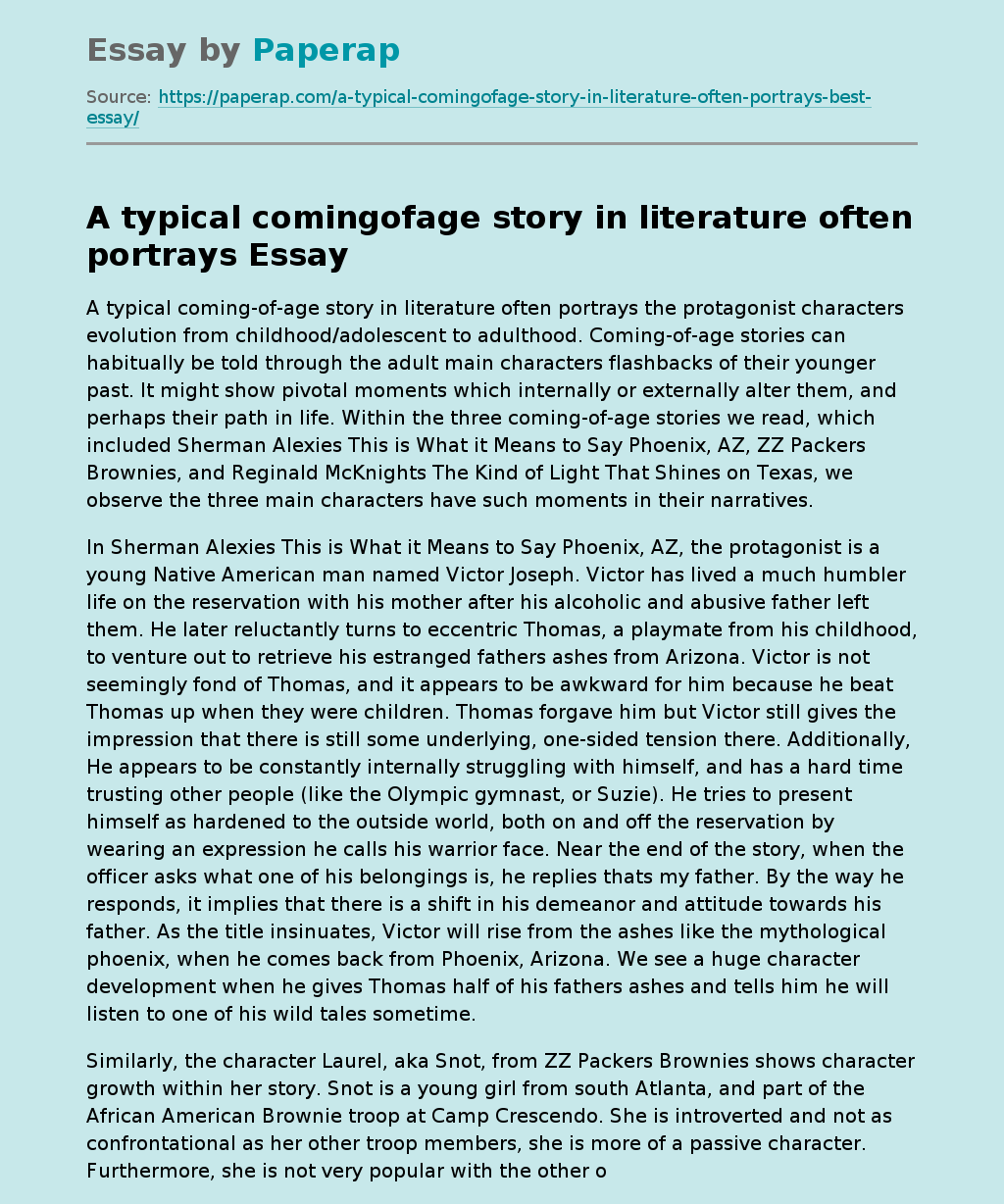A typical Comingofage Story in Literature often Portrays
A typical coming-of-age story in literature often portrays the protagonist characters evolution from childhood/adolescent to adulthood. Coming-of-age stories can habitually be told through the adult main characters flashbacks of their younger past. It might show pivotal moments which internally or externally alter them, and perhaps their path in life. Within the three coming-of-age stories we read, which included Sherman Alexies This is What it Means to Say Phoenix, AZ, ZZ Packers Brownies, and Reginald McKnights The Kind of Light That Shines on Texas, we observe the three main characters have such moments in their narratives.
In Sherman Alexies This is What it Means to Say Phoenix, AZ, the protagonist is a young Native American man named Victor Joseph.
Victor has lived a much humbler life on the reservation with his mother after his alcoholic and abusive father left them. He later reluctantly turns to eccentric Thomas, a playmate from his childhood, to venture out to retrieve his estranged fathers ashes from Arizona.
Victor is not seemingly fond of Thomas, and it appears to be awkward for him because he beat Thomas up when they were children. Thomas forgave him but Victor still gives the impression that there is still some underlying, one-sided tension there. Additionally, He appears to be constantly internally struggling with himself, and has a hard time trusting other people (like the Olympic gymnast, or Suzie). He tries to present himself as hardened to the outside world, both on and off the reservation by wearing an expression he calls his warrior face.
Near the end of the story, when the officer asks what one of his belongings is, he replies thats my father.
By the way he responds, it implies that there is a shift in his demeanor and attitude towards his father. As the title insinuates, Victor will rise from the ashes like the mythological phoenix, when he comes back from Phoenix, Arizona. We see a huge character development when he gives Thomas half of his fathers ashes and tells him he will listen to one of his wild tales sometime. Similarly, the character Laurel, aka Snot, from ZZ Packers Brownies shows character growth within her story. Snot is a young girl from south Atlanta, and part of the African American Brownie troop at Camp Crescendo. She is introverted and not as confrontational as her other troop members, she is more of a passive character. Furthermore, she is not very popular with the other outspoken girls in her group, who consistently put her down through words or actions. She does however try to rationalize and reason with the other girls when conflict arises between them and the Caucasian troop.
She tries to convince Arnetta and Octavia that they could be wrong about Troop 909 saying racist remarks, Hey-maybe you didn’t hear them right. Surprisingly, it was her realization though that the only time the other troop would be unsupervised would be in the bathroom, so some blame falls upon her on behalf of the confrontation. She also realizes from her fathers story of the Mennonite man, that his behavior is quite similar to that of Arnetta and Octavia. There is a strong emphasis of racial segregation and prejudice as the main themes within the story. Although, I do not believe that Snot holds as much racism or prejudice as the other girls. By the end of the story Snot understands that she must start speaking up for herself because the world can be a cruel place, and a slight loss of childhood innocence with that realization.
Likewise, in the final story we read called The Kind of Light That Shines on Texas, we were greeted with the main character Clinton. He is an African American boy in sixth grade who lives in a predominantly Caucasian part of Waco, Texas in the 60s. He loves and respects his mother but has a disconnection in communicating with her. Racism is very much alive in his little community, from the rude remarks of his teacher, sometimes the class bully, and even from his own inner thoughts. He is one of the only three African American children in his class. Clinton vividly internally voices his animosity and disapproval for Marvin Pruitt, one of his African American classmates. He believes Marvin plays into the undesirable stereotypes and hates his.
Own skin color because of that, which makes him feel ashamed. He so desperately wants to distance himself from such stereotypes, which he does by dressing exceptionally well, staying alert in class, and even by fake laughing at his teachers racist jokes. In the concluding moments of the story, we see that Clinton actually stands up for himself against Oakley, the older hostile bully. That confrontation results in one of the storys major conflicts, in which Clinton asks Oakley why he wants to fight him and not Marvin, who is bigger. Lastly, when Oakley tries to fight Clinton, Marvin defends him without hesitation. Clintons view of Marvin in the aftermath is altered in a more positive light.
In conclusion of my character analysis response, I believe each story displayed a distinct evolution of each core character. These coming-of-age stories all held some striking similarities, such as the absence of a father/father figure in their life, each faced racism in their environment, and a more self-aware character produced in the end. They all relatively held the theme of person vs. society. Each of the central characters overcame certain prejudices and gained a healthier self-efficacy. Overall, these stories were entertaining and a delightful read.
A typical Comingofage Story in Literature often Portrays. (2019, Dec 18). Retrieved from https://paperap.com/a-typical-comingofage-story-in-literature-often-portrays-best-essay/

